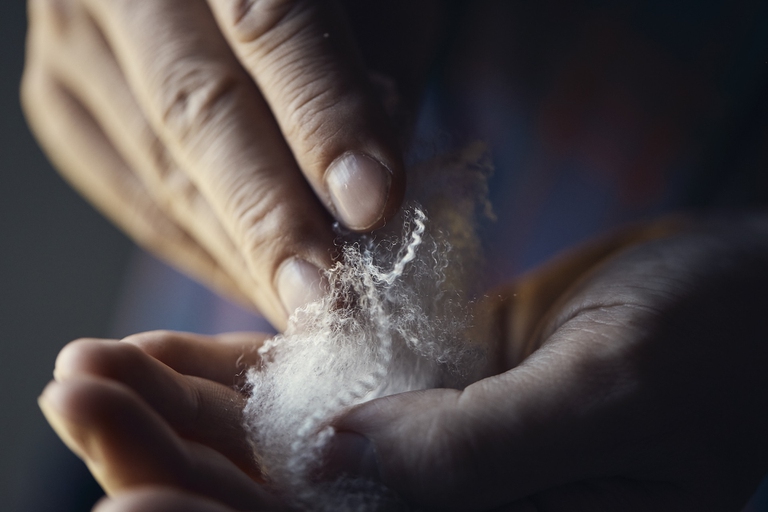https://www.lifegate.it/lana-costumi-da-bagno-ambiente
- |
If you have ever happened to browse through some seaside images from the 1930s, you will certainly have noticed, in addition to the extremely modest models, another crucial difference compared to the swimsuits to which we are accustomed: they were made of wool.Material that, today, we are naturally inclined to associate with sweaters, socks, scarves, in short, with items of clothing designed to protect us from the coldest temperatures.Yet at the time it was considered a more than valid option, on the one hand because swimming was not so widespread and few people could afford to go on holiday, on the other because Knitting people were able to make their own costumes. Elasticity and good covering ability (let's remember that we are talking about an era in which the body was not discovered in such a casual way as it happens today) they made wool the perfect material for swimsuits.
Of course, at the time it was not worked as well as it is today and tended to become considerably heavier once wet, but thetextile industry started precisely from this material to start creating costumes intended for commercial use, the ones we know today.Suffice it to say that the first swimsuit manufacturing company, i.e Speedos, was originally born as knitwear factory during the first decades of the twentieth century:founded by a Scotsman who emigrated to Australia, Alexander MacRae, had started its business producing socks for the army during the First World War and then moved on to costumes only later, introducing nylon not before the 1950s.

Swimwear:wool vs polyester
In fact, before the advent of polyester, there were no "technical clothing" as we know them today:swimsuits, but also windbreakers or thermal shirts.Today it seems impossible to do without that prodigious fiber that is polyester:rigidity, flexibility and, last but not least, a low cost, make this very popular material.We must not forget that we are talking about one hyper versatile fibre, which allows you to "imitate" the qualities of a large number of natural fibres, from silk to animal hair and wool.These imitations, over time and with research, have become increasingly convincing and the result is that today we can have a strong fibre, resistant to abrasions and tears and capable of withstanding numerous washes without changing its fit. .
A prodigious fibre, in short, which is not difficult to understand why it is so loved by the textile industry and in particular by that oftechnical clothing.The big problem with clothing made from polyester, however, is that they are highly polluting:this miracle fiber is in fact derived from oil and, although the textile industry is growing equipping to produce more sustainable alternatives from an environmental point of view, such asEconyl made from recycled fishing nets, the presence of textile fibers produced from scratch by petrolatum it is still very high.
This type of material is energy intensive:production requires a very high CO2 consumption and, as if that wasn't enough, they are dispersed microplastics in water with every wash.The paradox is that the success of such a fiber depends on whether it is capable of imitate the qualities of natural fibers such as wool, which on the other hand requires less energy to be produced, is more easily recyclable, does not produce microplastics, is 100 percent biodegradable, it is durable over time and is also responsible for the survival of many vulnerable communities which in various parts of the world are supported by the breeding of sheep or goats for its production.

Today that the desire to sustainable clothing and respectful of the environment, and consequently also of swimwear, is clearly growing, the research and development around this topic is making giant strides and today we can count on the reintroduction of wool into the world of swimwear in a way that is certainly more comfortable and functional than that experienced by bathers in the 1930s.Today, swimming in a wool bathing suit no longer means getting out of the water with a garment that doubled its weight, but being able to count on a boss breathable, thermoregulator And capable of absorbing humidity:Furthermore, merino wool is also a fiber that providesexcellent protection from UV rays, so much so that it was used to make the uniforms of British soldiers in the colonial era precisely to keep them protected from the heat and humidity of tropical climates.This happens because wool is a hollow fiber and, as such, it manages to keep body temperature stable by balancing it with the external temperature, which is why it is not a contradiction to think about wearing it in August under an inclement sun.Furthermore, it absorbs humidity and releases it towards the outside wool does not stink even in the presence of sweat:in fact, it manages to absorb the molecules that generate bad odor, releasing them only during the washing phase.
The advantages of using wool
A natural fiber like wool presents several advantages from an environmental point of view:first of all his production is not energy intensive and, if you rely on certified producers, like those enclosed by the hat The Woolmark Company which is the consortium of Merino wool producers, there is also a guarantee with respect to breeding conditions of the 71 million Australian sheep that produce a yarn that is 100 percent natural, 100 percent biodegradable – when a wool fiber is disposed of, it naturally decomposes in the soil within a few years while releasing nutrients for the earth – and 100 percent renewable.Another advantage not to be overlooked is the ability to be recycled:a garment that is made of 100 percent wool is easily and effectively recyclable:although wool represents only 1.2 percent of the total production of virgin fibres, some research has shown how this is one of the most used fibres for the production of new products such as clothing, mattresses and coverings.

In short, the advantages in choosing the wool swimwear There are many and just as many reasons for preferring this fiber to polyester:to date there are not many brands that produce wool swimsuits, but theoffer is expanding from year to year.The greatest concentration, if we want to call it that, is currently found in Oceania with Merino swimsuit And Swimm, brands that make wool costumes, the first more technical-retro, the second more fancy and fashionable.In our latitudes, however, we find collaborations with the French brand Vilebrequin and Italian Arena with The Woolmark Company:who created swimsuits in extrafine Merino wool.
